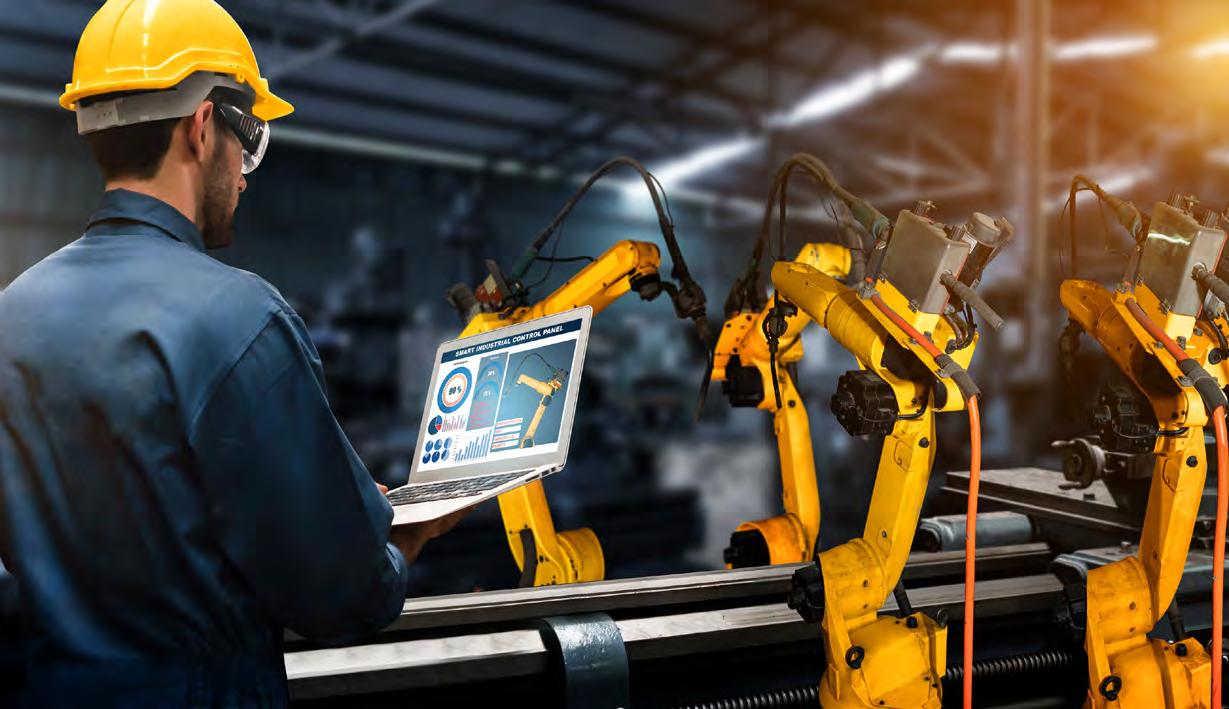The Aptean 2022 Manufacturing Forecast:




It’s been an unpredictable and challenging couple of years for manufacturing, with the pandemic and other global events pushing operational capabilities to their limits for many organizations. But as the focus shifts from business survival and cost management to increasing demand and financial recovery, what will the manufacturing industry look like over the next 12 months?
To benchmark how manufacturers are performing and look at their business priorities for the year ahead, Aptean surveyed 275 North American manufacturing organizations.
We’d like to share our critical findings in a 2022 manufacturing forecast – and provide tailored guidance to help your business overcome obstacles, increase profit margin and maximize sales and revenue in the next 12 months.



“We want to track and simplify our vendor supplies and keep inventory flows realistic.”
“We need to increase sales and profits but our inability to efficiently gather and analyze data stops us from making the best business decisions.”
“We want to add more employees at a new location as we’ve picked up more business.”
“As the world changes we need to evolve with it, in order to serve our customers better and faster.”
“Our main focus for 2022 is automating technology across the company’s production process.”
The manufacturing sector is on an upward curve. Industry output has grown fairly consistently over the past twelve months, and 78% of the manufacturers we surveyed feel more optimistic heading into 2022 compared to 2021 – which is encouraging news. 78% also believe that their sales and revenue will be higher in 2022.
Sectors that experienced growth during the pandemic are even more confident. For example, 89% of CBD manufacturers have a positive outlook for 2022, after sector revenue surpassed $6.3 billion at the end of 2020. 89% of personal care manufacturers are also confident about market conditions, which aligns with analyst predictions of 4.82% CAGR between now and 2026.
Looking at manufacturers’ 2022 business goals, we can sense this optimism in their objectives. The companies we surveyed are moving beyond cost management, focusing on increasing revenue and improving profit margin over the next 12 months.
78% of manufacturers believe their sales and revenue will be higher in 2022 than 2021.
the data
income for
are
see how
and discovered
in operation
the impact of the
less)
their inexperience and limited resources when dealing with

to the fact
systems
61% of manufacturers with a turnover of $500m+ say they’re back to prosperity, compared to 46% of manufacturers with $100-499m turnover and just 32% of manufacturers turning over less than $99m.
In fact, larger manufacturers are so optimistic about their capabilities that they’re already on the front foot; while most organizations are focused on profit and sales growth, the number one business priority for enterprise manufacturers in 2022 is R&D.
Clearly, there are green shoots of recovery – even prosperity – in the manufacturing sector. And larger, more established organizations are already focused on business development and innovation. But what could stop manufacturers of all sizes from growing sales and revenue post-pandemic?
R&D is the number one business priority for enterprise manufacturers in 2022
Company size also significantly affects how well manufacturers have weathered the pandemic storm.
Aptean’s research has identified five critical priorities that manufacturers must address to thrive in 2022


Supply chain is by far the most pressing issue for manufacturers right now, as material limitations and logistics disruptions impact trading capabilities. In fact, IHS Markit data revealed a near-record lengthening of manufacturing supply chains in October 2021.
Our research findings showed the severity of supply chain challenges. A third of manufacturers admitted they are currently experiencing upstream supply issues, while a further 28% are enduring downstream problems with packaging and deliveries – meaning over 60% of manufacturers are still troubled by their supply chain in some way. And discrete manufacturers are worst affected.
Our survey showed that while a similar percentage of discrete and process manufacturers are experiencing supply chain disruption (86% versus 90%), only 14% of process manufacturers say the issue is getting worse – compared to 1 in 5 discrete manufacturers. This may be a reflection of the global semiconductor shortage; we’ve already seen Nissan announcing that is will produce 500,000 fewer cars in 2021 due to this issue.
Over 60% of manufacturers are still experiencing supply chain disruption.

plays
Our research also revealed a clear recognition that digital transformation is required to meet supply chain challenges more effectively: 66% of manufacturers believe that technology is extremely important in building supply chain resilience. What’s interesting is how manufacturers think technology should be applied.
For example, enterprise manufacturers are most interested in supply chain contingency planning,

and they’re also more likely to have already carried out a supply chain vulnerability audit than smaller organizations (61% of manufacturers with $500m+ turnover have done an audit, compared to the industry average of 50%).
This shows that organizations with greater resources and bigger budgets want to measure risk and look at ‘what if’ scenarios, to put plans in place for dealing with multiple supplier setbacks.
Our analysis of current supply chain challenges has identified the major causes of disruption, as well as measuring how significantly material delays are affecting lead times, and sharing how manufacturers are planning to protect their business going forward. But general analysis can only provide so much guidance.
To help your manufacturing organization thrive in 2022, Aptean has created a tailored set of priorities for overcoming each major sector challenge – and here is our high-level guidance for improving supply chain resilience and agility in 2022:
If supply chain is priority number one then inventory management is priority number two, as these operational areas work hand-in-hand. Supply chain disruption inevitably affects material availability, and many manufacturers are struggling to balance availability and demand.

A third (32%) of the manufacturers Aptean surveyed said they are finding it a significant challenge to maintain inventory levels at the moment – with process manufacturers (39%) struggling more than discrete manufacturers (28%). And scaling businesses (those with a turnover over of $100-499 million) are finding it a particular growing pain; 41% reported inventory management as a major issue.
What’s interesting to note is that material availability isn’t just a challenge for struggling and recovering manufacturers. More than a quarter (28%) of manufacturing organizations say inventory control issues are affecting their ability to increase capacity – which means prospering businesses are also being constrained by material management issues.
A third of manufacturers are currently struggling to maintain inventory levels.The Aptean
When we looked further into the issue of inventory control, the root cause of current problems became clear: data.
At the moment, 25% of manufacturers aren’t able to align their production schedule with material availability. And when we analyze data visibility and integration across manufacturing operations, the problem becomes even more significant.
65% of the manufacturers we surveyed admitted to having significant gaps in their business data. Over half (54%) said they didn’t fully trust the accuracy of their data, while 53% said their business data is not
The impact of data disconnections is felt most strongly in parts of the business which rely on immediate, accurate, trustworthy information –like inventory management. Which is why we weren’t surprised to learn that 84% of manufacturers plan to put technology in place within the next 12 months that will improve their production scheduling capabilities.

in 4 manufacturers can’t
Even before the pandemic, manufacturing was in a period of significant change, with the current skilled labor force ageing out and organizations struggling to replace their knowledge and capabilities. COVID-19 has pushed the industry into a full-scale labor crisis, with up to 3.5 million manufacturing jobs needing to be filled over the next decade.
Our research revealed that manufacturing companies are fighting a recruitment battle on two fronts: finding enough employees to run an efficient operation (30% are currently experiencing staffing shortages – rising to 35% in larger enterprises), and finding people with the right skills (4 in 10 manufacturers are reporting skills shortages, including 6 in 10 enterprise manufacturers).
The optimism many manufacturers feel entering 2022 can only be converted into sales and revenue improvements if there’s enough people with the right skills carrying out high-value tasks. But this is easier said than done.
4 in 10 manufacturers say being caught up in day-today demands is the biggest barrier to reaching their 2022 business goals, and this is being fueled by under-resourcing and skills shortages.

If being caught up in day-to-day demands is the number one barrier, it’s no coincidence that system integration is the second biggest challenge, as greater technology cohesion is the bedrock of workforce productivity.
Without a joined-up, data-driven approach to manufacturing operations, talented workers spend more time doing repetitive tasks or low value administration than activities where their skills are needed.
Digital investment will significantly improve the employee experience in 2022. 66% of the manufacturers we spoke to believe that technology will improve staff retention, but it needs to be introduced sensitively to promote positive change.
Many manufacturing professionals fear that process automation and software adoption will replace their job – when our research shows that manufacturing technology will enhance their roles, by improving productivity and helping employees to collaborate and share knowledge.
Our survey revealed that preventing knowledge loss was among the top reasons for investing in manufacturing technology, while 70% of manufacturers agree that digital software will improve the way they manage employee skills, staff retention and talent acquisition.

Manufacturers clearly see a business case in digitizing shop floor
technology to enhance workforce capabilities. But to improve recruitment rates and strengthen skills, technology needs to be deployed in a way that empowers – rather than disenfranchises – employees, to overcome job security fears and resistance to change.
If people feel part of the change-making process, the quicker and more confidently they will adopt technologies, and the quicker manufacturers will reap the benefits of digital transformation.
And while the initial technology focus may be around operation improvements and knowledgesharing, creating a culture of innovation and openmindedness will support manufacturers’ longer-term digitization strategies.
For example, 88% of manufacturing organizations are interested in using robotics. But despite staffing shortages, only 30% expressed an interest in replacing certain people or roles with roles or robots. Most want to use robotics to support their workforce, by spearheading dangerous and high risk tasks or taking over low value, repetitive tasks.

When we discussed supply chain challenges earlier, we touched on the fact that manufacturers needed to make difficult customer-oriented decisions during the pandemic – like delaying a lower value customer’s order when material supplies are limited, to prioritize a higher value customer.
This is just one example of how current market conditions are affecting customer acquisition and retention, and our research revealed the extend of market volatility on customer relationships.
30% of manufacturers say they’re finding it hard to bring in new business at the moment. And more fundamentally, 30% of manufacturers have lost customers during the pandemic – with smaller businesses ($0-99m turnover) most likely to lose business.

Reduced demand has also been an issue, especially among discrete manufacturers – 34% have been affected by a downward turn in demand, compared to just 22% of process manufacturers, with mid-size manufacturers hardest hit.
30% of manufacturers lost customers during the pandemic, with 29% also experiencing reduced demand.
While
For

And


Customers may have been understanding of
the height of the
and it’s better for struggling or
to
than cancel their
But companies are now focused on the future – and with most manufacturers in a state of recovery or prosperity,
value
will be higher in 2022.
Technology will be critical to meeting – and exceeding – customer demands, and our survey underlined the importance of customer experience in manufacturers’ business
First, technology integrates data and automates processes, which provides a more reliable, informed way of working for manufacturing professionals.
A digital dashboard displaying real-time data creates accurate delivery estimates and ensures that goods can be produced at speed without compromising on quality control. This high standard of work and improvement in on-time delivery rates enhances customer satisfaction, which drives repeat orders and new business referrals.
track
Second, the use of real-time, organization-wide data empowers manufacturers to spot potential service issues quickly and resolve them, rather than customers finding out at the eleventh hour that their order has been delayed or cancelled. While ideally every order should arrive on schedule, customers are more forgiving if their expectations are managed early-on.
labor
materials
in short supply.
provide instant-access information for
support
see the status of their orders real-time, while utilizing AI and data insights to forecast workload and manage the 360-degree customer experience.
a cloud-based

Throughout our research findings, we’ve identified a clear desire among manufacturers to use technology to deliver improvements and meet strategic goals –and many organizations are already deploying digital software to address their core challenges.
In 2021, there was a clear focus on investing in technology that could enable staff to either work from home or social distance in the workplace, which makes sense given the operational restrictions introduced during the pandemic.
However, if we look at manufacturers’ technology priorities for 2022, we can see a much more diverse set of goals. Quickly obtaining data on performance/ efficiency, increasing capacity to meet demand and addressing skills shortages are among the top investment initiatives for the next 12 months.
With so many business areas to optimize, it would be easy for manufacturers to approach technology in a disconnected manner – onboarding multiple, disparate systems to solve specific issues, while creating a whole new level of technical complexity for manufacturers to use, manage and maintain.
But many manufacturing organizations have already recognized this potential issue and are looking at ways to invest in fewer, more sophisticated technologies – like ERP software – as part of a defined digital transformation strategy.
In fact, 72% of manufacturers have a digital transformation roadmap in place for some or all of their department (even if they’re still unrolling it) to ensure every investment supports their underlying business objectives – and enterprise manufacturers are more likely to be ahead of the curve in this area.

The events of the pandemic taught manufacturers to expect the unexpected, and we can see the impact of this in companies’ business growth strategies for 2022. There’s a much greater focus on data visibility and operational agility, to both see emerging challenges and respond quicker to any problems that arise.
Our research has provided evidence of a clear business case for using manufacturing technology to integrate and automate processes, improve data insights, and make smarter, more responsive business decisions. And many manufacturers are already acting on this insight; 98% of the organizations we surveyed plan to be using digital software to obtain and analyze real-time performance data by the end of 2022.
Whether your manufacturing business is struggling, recovering or prospering, the most effective way to meet your year-ahead goals is to align your business development objectives with your digital transformation strategy.
Considering company goals and digital innovation collaboratively will ensure that technology investment delivers rapid, game-changing ROI – opening the door to increased sales revenue and greater profitability.

98% of manufacturers want to be extracting and analyzing real-time performance data by the end of 2022.
Get
Gain
We can transform
ensure you’re Ready for What’s Next, Now® through one of our three Manufacturing ERP Solutions: Aptean Industrial Manufacturing ERP, Aptean Process Manufacturing ERP and Aptean Food and Beverage ERP.

Aptean is one of the world’s leading providers of purpose-built, industry-specific software that helps manufacturers and distributors effectively run and grow their businesses. With both cloud and on-premise deployment options, Aptean’s products, services and unmatched expertise help businesses of all sizes to be Ready for What’s Next, Now®. Aptean is headquartered in Alpharetta, Georgia and has offices in North America, Europe and Asia-Pacific. To learn more about Aptean and the markets we serve, visit www.aptean.com.
Aptean and B2B International surveyed 275 North American discrete and process manufacturers in October 2021. B2B International is a global, full-service market research firm, specializing in researching B2B markets. Helping clients achieve their business goals by making smarter decisions driven by insights.
